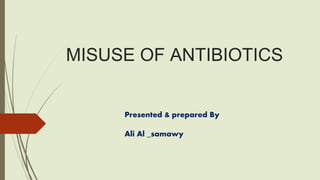The document discusses the misuse of antibiotics, outlining their definitions, mechanisms of action, and the evolution of antibiotic resistance. It highlights factors contributing to resistance, such as inappropriate use and patient compliance, while suggesting measures to minimize misuse. Additionally, it compares antibiotic usage practices in Iraq and the USA, emphasizing the importance of proper antibiotic stewardship.



























